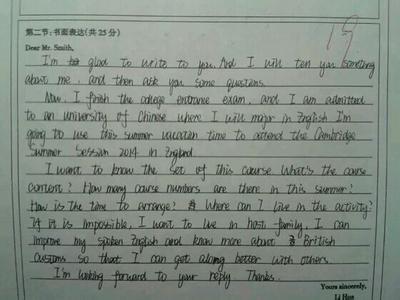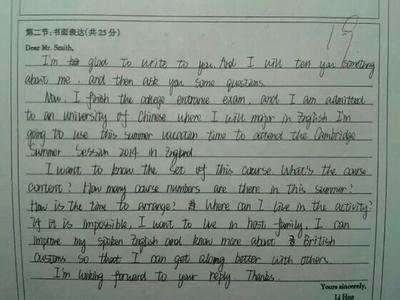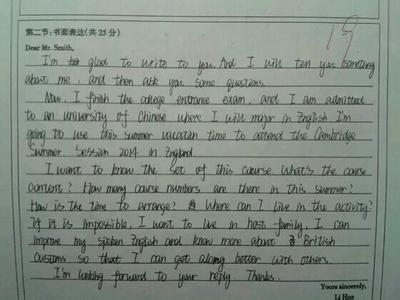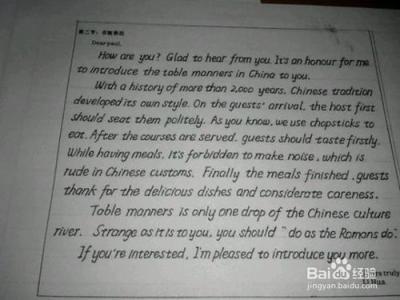俗话说:“千里之行,始于足下。”英语书面表达能力的形成不是一日之功,必须从平时的课堂学习一点一滴抓起,持之以恒。一篇优秀的英语作文在内容和语言两方面应是一个统一体,任何一方面的欠缺都会直接影响到作文的质量。
中考英语作文万能句子(三)41. The + adj.比较级, the + adj.比较级 越……,越……
此句型表示一方随另一方的变化而变化。
例如:The harder he works, the happier he feels。他工作越努力,就感到越幸福。
The more, the better. 多多益善。
The more I read this book. 这本书我越读越喜欢。
42. There be句型
①在此结构中,there是引导词,在句中不能充当任何成分,也不必翻译出来。句中的主语是某人或某物,谓语动词be要与主语的数保持一致。例如:There is a man at the door. 门口有一个人。
当主语是由两个或者两者以上的名词充当时,谓语动词be要跟它邻近的那个名词的数一致(就近一致)。
例如:
There are two dogs and a cat under the table。桌下有两只狗和一只猫。
比较:There is a cat and two dogs under the table。
②There be句型中的be不能用have来代替,但可以用lie(位于,躺),stand(矗立),exist(生存),live(生活)等词来替换。例如:There stand a lot of tall buildings on both sides of the street。街道两旁矗立着许多高楼。
There lies lake in front of our school. 我们学校前面有一个湖。
Once there lived a king here. 这儿曾经有一个国王。
There is going to be a sports meeting next week。下周准备开一个运动会。
与there be 类似的结构: there seem(s)/happen(s) to be…
There seems to be one mistake in spelling. 似乎有一处拼写错误。
There happened to be a ruler here. 这儿碰巧有把尺子。
There seemed to be a lot of people there. 那儿似乎有很多人。
43. too + adj. /adj. +to do sth. 太……以至于不……。
此句型为简单句,后面的to表示否定含义。
例如: The ice is too thin for you to walk on. 这冰太薄,你不能在上面走。
The bag is too heavy to carry. 这个袋子太重搬不动。
44. used to do sth. 过去常常做某事
used to是情态动词,表示过去的习惯动作或状态,现在已不存在,因此只用于过去时态。
例如: He used to get up early. 他过去总早起。
When I was young, I used to play tennis very often。我年轻时经常打网球。
否定形式有两种:didn’t use to;used not to,例如: 他过去不常来。
He didn’t use to come. = He usedn’t to come。
45. what about…? ……怎么样? 后面可接名词、代词、动名词等。与“how about…?”同义。例如:
We have been to Hainan. What about you? 我们去过海南,你呢?
What about going to the park on Sunday? 星期天去公园怎么样?
46. What day/date is it today? 今天星期几(几月几日)?
What day is it today?今天星期几?-Sunday. -What date is it today? -June 24th。
47. What’s wrong (the matter) with…? ……怎么了?
What’s wrong with you, Madam? 夫人,您怎么了?
You look worried. What’s wrong with you? 你看上去很焦急,出什么事了?
48. Why not do…? 为什么不做……?
谓语动词用原形。与Why don’t you do…?同义。例如:Why not go to see the film with us?
= Why don’t you go to see the film with us?为什么不和我们一起去看电影呢?
49. would like to do sth. 想做…… like后用动词不定式作宾语,也可用名词作宾语。
例如: I would like to drink a cup of tea。我想喝一杯茶。
疑问句式: Would you like (to drink) a cup of tea? 你想喝杯茶吗?
50. adj./adv. 比较级 + and adj. /adv. 比较级
越来越......
若形容词/副词为双音节词及多音节词,则这一结构变为“more and more +形容词/副词”。
例如:It’s getting warmer and warmer. 天气变得越来越暖和了。
The little girl becomes more and more beautiful。小女孩变得越来越漂亮了。
51. adj.比较级+than
than引导的是典型的比较级句型,表示“一者比另一者……”,起前用形容词或副词的比较级,than从句可以用省略形式。例如:I know you better than she does. 我比她更了解你。
This house is bigger than that one. 这所房子比那所房子大。
52. though-从句
though引导的是让步状语从句,意思是“虽然……但是……”。但不能和but连用,英语中表达“虽然……, 但是……”时,though和but只能用一个。例如:
Though it was snowing, it was not very cold. 虽然下着雪,可并不太冷。
I was late for the last bus though I hurried。虽然我拼命赶路,还是没搭上最后一班公交车。
We didn’t feel tired though we walked a long way。虽然我们走了很长的路程,但是并没有感到累。
53. if-从句
If 引导的是条件状语从句,“如果;假如”。如主句用一般将来时,if从句要用一般现在时(主将从现)。例如:If I go to the Great Wall tomorrow, would you like to come along?
如果明天我去长城,你会和我一起去吗?
If it rains tomorrow, I won’t go.
如果明天下雨,我就不去了。
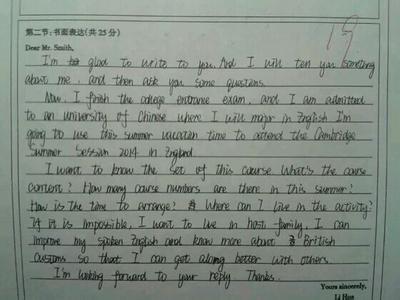
54.because-从句
引导原因状语从句,“因为”。 例如: He didn’t hear the knocking at the door because he was listening to the radio. 他没有听见敲门声,因为他正在听收音机。
55. so + do/be + 主语
“So + be/助动词/情态动词 + 主语”表示前面所述内容也适用于另一人或物。be、助动词或情态动词的选择视前面陈述句中谓语动词的时态形式而定。
例:He likes football and so do I. 他喜欢足球,我也如此。
Jim was playing football just now and so was Tom。刚才吉姆在踢足球,汤姆也在踢足球。
比较: “So+主语+be/助动词/情态动词。”结构,是用来证实前一句所表达的内容(起强调作用)。be、助动词或情态动词的选择视前面陈述句中谓语动词的时态形式而定。
A: It is very hot today.
B: So it is. 确实如此。
A: He can swim.
B: So he can。
56. not only…but also… 不但……而且……
常用来连接语法作用相同的词、短语或句子。连接两个主语时,谓语动词要和紧靠它的主语在人称和数上保持一致。
例如:She likes not only singing but also dancing. 她不但喜欢唱歌,而且喜欢跳舞。
He is not only a good doctor but also a good father。他不但是个好医生而且是个好爸爸。
Not only I but also he is hoping to go there. 不但我而且他也想去那儿。
Not only you but also his father likes football and basketball. 不但你喜欢足球和篮球,而且她的父亲也喜欢。
57. prefer…to… 喜欢……胜过…
prefer (doing) sth. to (doing) sth.意为“两者相比更喜欢(做)其中之一”。在此结构中,to是介词,接名词或动名词,结构中前后所跟成分一样。例如:
He prefers tea to coffee. 茶与咖啡相比,他更喜欢茶。
He prefers doing shopping to going fishing。购物与钓鱼相比,他更喜欢购物。
58. 感叹句型
What (a/an) + adj. + n. +主语+谓语! How +adj./adv.++主语+谓语!
例如:
What a clever boy (he is)!
How clever the boy is!
What a wonderful film we saw last night! 昨天晚上我们看的电影多精彩啊!
How lovely the weather is! 天气多好啊! How hard he works! 他工作多么努力啊!
59. 祈使句型
祈使句型表示命令、请求、劝告等含义。说话的对象通常为第二人称,习惯上常省略。句末用句号或感叹号。肯定祈使句是:谓语动词用动词原形表示。
否定祈使句是: 在谓语动词前加do not(don’t)。例如: Be here on time tomorrow。明天准时到这儿来。 Say it in English! 用英语说!
Don’t be afraid! 别怕! Don’t look out of the window! 不要朝窗外看!
60. 并列句型
用并列连词连接起来的两个或两个以上的简单句叫并列句。连接并列句常用的连接词有:and, but, or, so, however, not only…but also, neither…nor, either…or…等。例如:
I help her and she helps me。
He is very old but he is in good health. 他年纪很大了,但他身体很好。
We must hurry, or we’ll be late. 我们得赶快走,不然就晚了。
Kate does her work carefully, so she never makes any mistakes。凯特工作很认真,从不出错。
 爱华网
爱华网